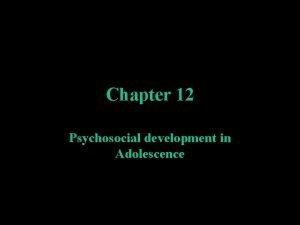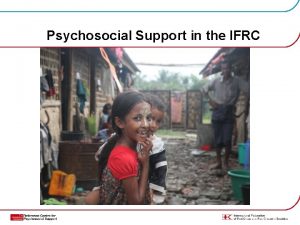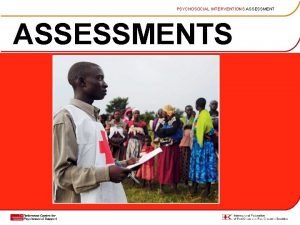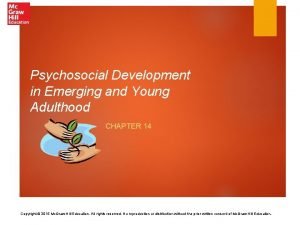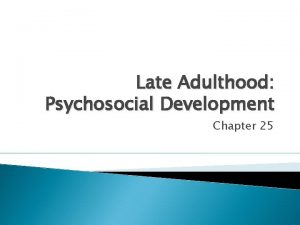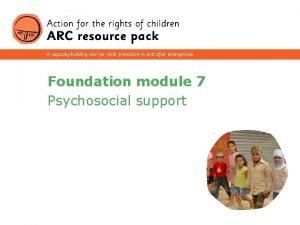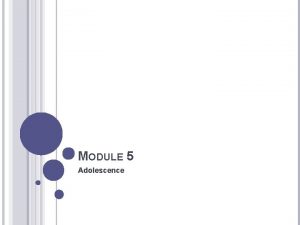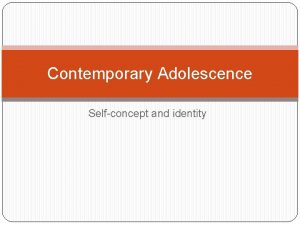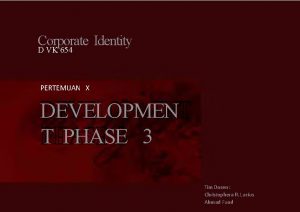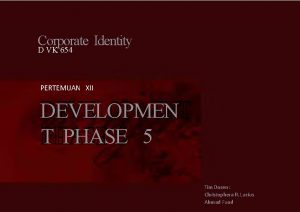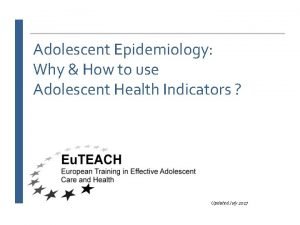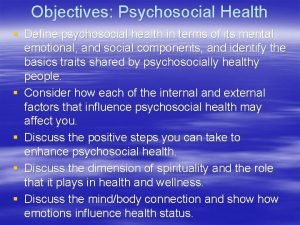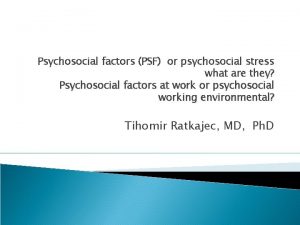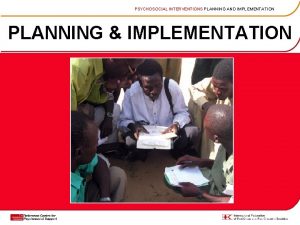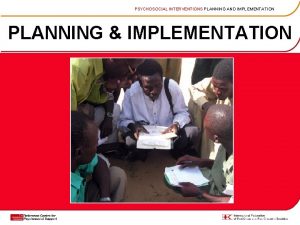Psychosocial Developmen in Adolescence Identity Why an Adolescent























- Slides: 23

Psychosocial Developmen in Adolescence

Identity: Why an Adolescent Issue? Changes in the way we see and feel about ourselves occur throughout the life span Adolescence marks the first restructuring of one’s sense of self at a time when he or she can appreciate the significance of these changes 2

Identity: Why an Adolescent Issue? Physical changes of puberty Cognitive changes Appearance Relationships with others Insert Photo from DAL Imagine possible selves Develop a future orientation Social changes In self-conceptions In self-esteem In sense of identity 3

Changes in Self-Conceptions Self-conception is the way individuals think about and characterize themselves (traits and attributes) During adolescence, more complex, abstract self -conceptions develop Personality is expressed in different ways in different situations

The multiple selves of a 15 -year-old girl 5

Changes in Self-Conceptions False-Self Behavior Acting in a way that one knows in inauthentic or fake Most likely to happen in dating situations Least likely to happen around close friends Insert Photo from DAL 6

Changes in Self-Esteem 7 Self-esteem How an individual feels about him or herself Self-esteem is fairly stable over time Baseline self-esteem: The way that adolescents typically feel about themselves overall (e. g. , “I am a good person”) Adolescents’ feelings about themselves fluctuate day by day Barometric self-esteem: The way that adolescents feel about themselves depending on specific events of that day (e. g. , “I feel bad that I was mean to my friend”)

Changes in Self-Esteem 8 During early adolescence Increased volatility in barometric self-image Different trajectories for different adolescents Young adolescents with the most volatile barometric selfesteem report the highest levels of anxiety, tension, psychosomatic symptoms, and irritability

Differences in Self-Esteem 9 Gender differences in self-esteem (boys > girls) become smaller over course of adolescence more pronounced among white and Puerto Rican teens less pronounced among African-American teens Middle-class > lower SES have higher self-esteem than their less-affluent peers SES discrepancy grows larger over the course of adolescence African-American girls > white/Hispanic Do not feel as negative about appearance Have higher overall self-esteem Show less of a decline in self-esteem over adolescence

10 Self-Esteem of American Adolescents African American (Self-Esteem Highest) White Adolescents Hispanic American Asian American Native American

11 Ethnic Differences in Self. Esteem During Adolescence Higher self-esteem among African-American teens Benefit from support/positive feedback of adults in the African-American community, especially in the family Focus on areas of strength, not weakness Have a strong sense of ethnic identity that enhances selfesteem

12 Ethnic Differences in Self. Esteem During Adolescence Lower self-esteem among Hispanic-American teens Lower levels of authoritative parenting Lower levels of perceived teacher support Weaker sense of ethnic identity Higher levels of family stress

Antecedents and Consequences of High Self-Esteem 13 Across all demographic groups, self-esteem is related to: Parental approval Peer support Success in school Teens who derive self-esteem from peers, rather than teachers or parents, show more behavioral problems and poorer school achievement

Parenting

Parenting Authoritarian Parenting Pattern -Controlling – using standard set of rules -Stress Obedience -No “give-and-take” -May use physical punishment

Parenting Authoritative Parenting Pattern -Explain & discuss rules & expectations -Maintains firm control -Set high standards -Encourage independence -Respectful of child’s point of view

Parenting Indulgent parents behave in an accepting, benign, and somewhat more passive way Indifferent parents try to minimize the time and energy that they must devote to interacting with their child

Sexuality

Sexuality as an Adolescent Issue Changes in the nature and meaning of sexual behavior Sexual activity can now lead to pregnancy Sexuality is influenced by Physical changes during puberty Emerging cognitive capabilities New psychosocial concerns

20 Sexual Activity During Adolescence Sexual Intercourse During Adolescence By the end of sophomore year of high school, more than 40% have had heterosexual vaginal intercourse For many girls (~30%), the first sexual experience is not voluntary

The Timing of Sexual Initiation 21 Adolescents are more likely to lose their virginity during certain times of the year June and December are peak months May, June, July common regardless of romantic involvement (prom, graduation) Holiday season in December is peak time for serious relationships

Parental Influences on Sexual Activity 22 Authoritative parenting is associated with adolescents who are Less likely to become sexually active at an early age Less likely to engage in risky sexual activity Parent-adolescent communication about sex Stops them from engaging in risky sexual behaviors, but does little to prevent them from being sexually active in general

Homosexuality during Adolescence q About 4% of adolescents identify as gay, lesbian, or bisexual (~ 8% in adulthood) Confusion is common about Sexual orientation – extent to which an individual is oriented toward heterosexual, homosexual, or bisexual activity Sex-role behavior – extent to which an individual behaves in traditionally masculine or feminine ways Gender identity – which gender an individual believes he/she is
 Training and developmen
Training and developmen Psychosocial development in adolescence
Psychosocial development in adolescence Hey bye bye
Hey bye bye Social identity map
Social identity map Don't ask why why why
Don't ask why why why Psychosocial development
Psychosocial development Relaxation response technique
Relaxation response technique Psychosocial environment
Psychosocial environment Types of psychosocial support
Types of psychosocial support Psychosocial information
Psychosocial information Infancy psychosocial development
Infancy psychosocial development Emerging adulthood psychosocial development
Emerging adulthood psychosocial development Psychosocial tasks
Psychosocial tasks Psychosocial development in late adulthood
Psychosocial development in late adulthood 7 psychosocial support
7 psychosocial support Erikson's psychosocial crisis
Erikson's psychosocial crisis Trust vs mistrust stage
Trust vs mistrust stage Muscular-anal stage
Muscular-anal stage Psychosocial development in early childhood
Psychosocial development in early childhood Test chapter 10 geriatric care
Test chapter 10 geriatric care Asesmen psikososial
Asesmen psikososial Types of psychosocial support
Types of psychosocial support Psychosocial and aesthetic factors
Psychosocial and aesthetic factors Psychosocial environment meaning
Psychosocial environment meaning

